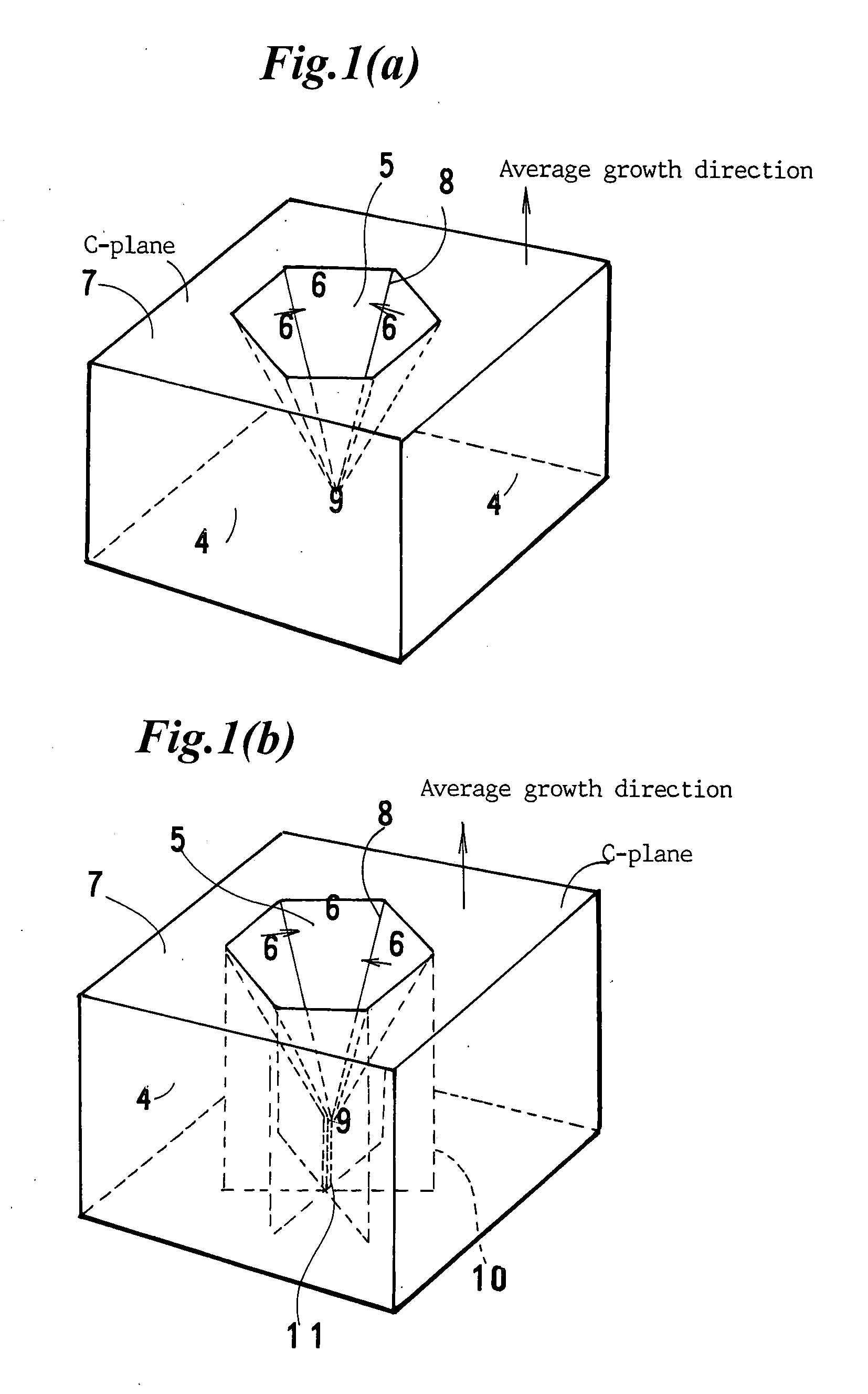Method of growing gallium nitride crystal
a gallium nitride and crystal technology, applied in the direction of single crystal growth, polycrystalline material growth, chemistry apparatus and processes, etc., can solve the problems of difficult crystal growth of gan in liquid phase, no practical size gan crystals with a diameter larger than 2 inches have been produced by liquid phase growth, and the current density of gan is large. , to achieve the effect of low defect density, low cost and low dislocation density
- Summary
- Abstract
- Description
- Claims
- Application Information
AI Technical Summary
Benefits of technology
Problems solved by technology
Method used
Image
Examples
embodiment 1
Dependence of Inversion Regions J Upon First Temperature Tj
[0125] Embodiment 1 studies how the occurrence of inversion regions J depends upon the first temperature Tj, which is the temperature at the step of making inversion regions J on masks.
[1. Undersubstrates (U)]
[0126] 2 inch diameter sapphire single crystal wafers (U1), 2-inch diameter GaAs single crystal wafers (U2) and 2-inch GaN / sapphire wafers (U3) which are 1.5 μm thick GaN layer coated sapphire wafers are prepared. The sapphire wafers (U1) are C-plane ((0001) plane) surface wafers. The GaAs wafers (U2) are GaAs(111)A-plane (Ga-plane) wafers. The GaN / sapphire wafers have C-plane sapphire wafers and 1.5 μm GaN thin layers deposited thereon. GaN / sapphire wafers are sometimes called “templates”.
[2. Mask Patterns (M)]
[0127] Masks should have a property of inhibiting GaN from epitaxial growing. 0.1 μm thick SiO2 layers are deposited on three kinds of undersubstrates U1, U2 and U3. Photolithography and etching pattern the ...
embodiment 2
Dependence on Growing Speeds Vj at a Temperature of 940
[0174] Embodiment 2 uses the same HVPE growth furnace as Embodiment 1. Embodiment 2 employs stripe / dotmasked GaAs(111) undersubstrates M1U2 and M2U2 prepared by forming an SiO2 stripemask M1 or SiO2 dotmask M2 on GaAs(111) undersubstrates U2. Embodiment 2 grows GaN crystals on the stripemasked and dotmasked undersubstrates by varying the growing speed Vj at a temperature of 940. Embodiment 2 investigates relations between the growing speed Vj and the facility of forming the orientation inversion regions J at 940.
[0175] The stripe / dotmasked undersubstrates M1U2 and M2U2 are laid on a susceptor in the HVPE reaction furnace. At an initial step, GaN buffer layers are grown on the undersubstrates for 15 minutes at a low temperature Tb of about Tb=500 by supplying HCl and NH3 at a NH3 partial pressure PNH3=0.2 atm (20 kPa) and an HCl partial pressure PHCl=2×10−3 atm (0.2 kPa). The thicknesses of the buffer layers are about 60 nm.
[0...
embodiment 3
Dependence on Growing Speeds at a Temperature of 1030
[0204] Repetitions of trials of Embodiments 1 and 2 suggest the inventors that the facility of inducing inversion regions J depends strongly upon the temperature Tj firstly and depends upon the growing speeds Vj at the temperature Tj secondarily. Embodiment 3 investigates dependence of inversion region occurrence upon growing speeds at a temperature of 1030 higher than Embodiment 2 (940).
[0205] Embodiment 3 uses the same HVPE growth furnace as Embodiment 1. Embodiment 3 employs stripe / dotmasked GaAs(111) undersubstrates M1U2 and M2U2 prepared by forming an SiO2 stripemask M1 or an SiO2 dotmask M2 on GaAs(111) undersubstrates U2. Embodiment 3 grows GaN crystals on the stripemasked and dotmasked undersubstrates by varying the growing speed at a temperature of 1030 different from Embodiment 2 (940). Embodiment 3 investigates relations between the growing speed and the facility of forming the orientation inversion regions J at 1030....
PUM
 Login to View More
Login to View More Abstract
Description
Claims
Application Information
 Login to View More
Login to View More - R&D
- Intellectual Property
- Life Sciences
- Materials
- Tech Scout
- Unparalleled Data Quality
- Higher Quality Content
- 60% Fewer Hallucinations
Browse by: Latest US Patents, China's latest patents, Technical Efficacy Thesaurus, Application Domain, Technology Topic, Popular Technical Reports.
© 2025 PatSnap. All rights reserved.Legal|Privacy policy|Modern Slavery Act Transparency Statement|Sitemap|About US| Contact US: help@patsnap.com



